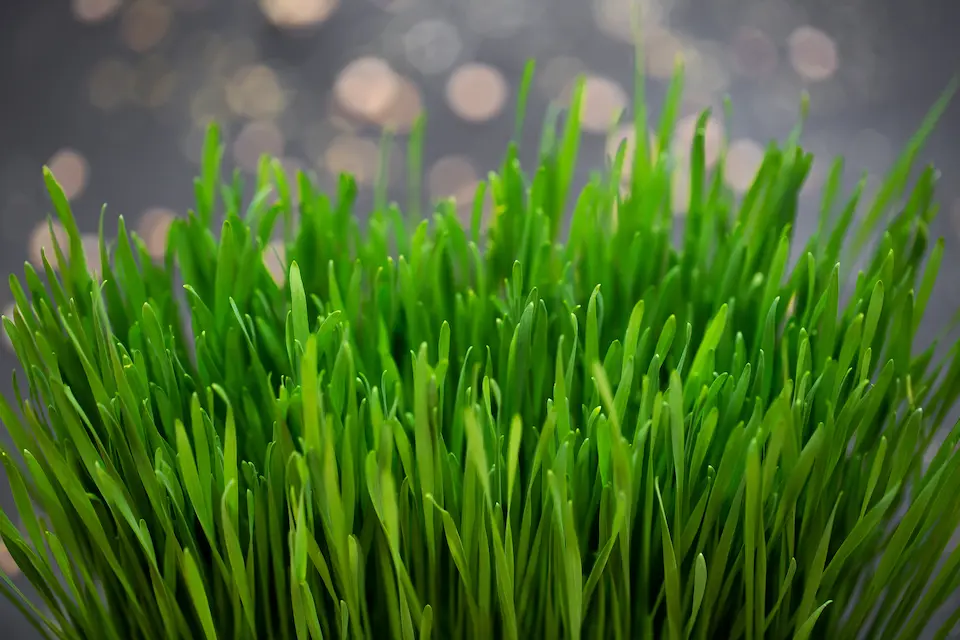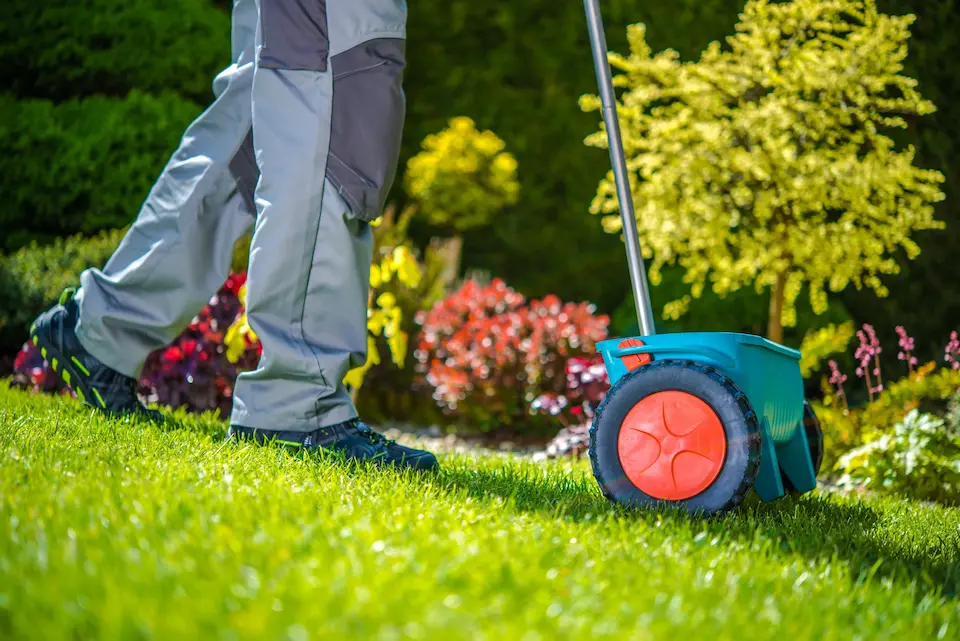A lush, vibrant lawn is a pride and joy for any homeowner, but maintaining a healthy lawn in Wake Forest’s unique climate can be a challenge. That’s where FortSmith Landscaping comes in. Our lawn care professionals understand the art and science of overseeding—a crucial technique for ensuring your lawn remains a source of envy in the neighborhood. Our landscaping experts are here to guide you through the intricate dance of timing, preparation, and care required to achieve the best results when overseeding your lawn.

What is Overseeding?
Overseeding is a lawn care practice that involves spreading grass seed over an existing lawn. The primary purpose of overseeding is to enhance the density of grass in your lawn, filling in gaps and thin areas. This process rejuvenates your turf, giving it a fuller and healthier appearance. Overseeding is not the same as reseeding, which typically involves starting a new lawn from scratch. Instead, overseeding complements your existing grass, promoting its vitality and resilience.
What Are the Benefits of Overseeding a Lawn?
A lush and healthy lawn can greatly enhance the beauty and value of your property. One of the essential practices in lawn care is overseeding, but what are the benefits of overseeding, and why should you consider it for your lawn?
Improved Aesthetic Appeal
One of the most noticeable benefits of overseeding is the transformation of your lawn’s appearance. Thin or bare patches are replaced with new, vibrant grass, resulting in a lush, uniform green carpet that boosts your home’s curb appeal.
Enhanced Lawn Health
Overseeding promotes the overall health of your lawn. By introducing new grass varieties such as fine fescue or grass seed mixtures, you can increase disease resistance and tolerance to environmental stressors. This diversity in grass types can help your lawn thrive in various conditions.
Weed Suppression
A dense, healthy lawn is more effective at crowding out weeds. Overseeding can naturally discourage the growth of unwanted plants, reducing the need for chemical weed control.
Erosion Control
A well-seeded lawn with strong root systems can prevent soil erosion, especially on slopes and uneven terrain. The grass acts as a stabilizing force, keeping your soil in place during heavy rainfall.
Drought Tolerance
Certain grass varieties used in overseeding are more drought-tolerant than others. By incorporating these varieties, you can make your lawn more resilient during dry spells, reducing the need for excessive watering.

The Best Time to Overseed in Wake Forest, NC
The local climate plays a significant role in overseeding success. Timing your overseeding project to align with the weather patterns in Wake Forest can maximize your chances of achieving a lush lawn. Let’s take a look at the seasonal breakdown of the pros and cons of when to spread seed for overseeding.
Fall Overseeding (September to November)
Pros:
- Cooler temperatures: Fall in Wake Forest offers a break from the scorching summer heat, creating ideal conditions for grass seed germination and establishment.
- Adequate rainfall: The region typically receives more rainfall in the fall, reducing the need for extensive watering.
- Reduced weed competition: Many weeds slow down their growth in the fall, allowing newly seeded grass to establish without as much competition.
Cons:
- Timing: The window for fall overseeding can be narrow, and timing is critical. Starting too late may expose the grass seedlings to winter frost before they establish strong roots.
Spring Overseeding (March to April)
Pros:
- Early growth: Spring overseeding allows grass to establish early in the growing season, giving it a head start on summer stressors.
- Favorable weather: Spring temperatures in Wake Forest are generally mild, which can provide optimal conditions for grass growth.
- Longer establishment period: Grass seed sown in the spring has more time to establish before the arrival of hot summer weather.
Cons:
- Increased competition with weeds: Spring is prime time for weed growth, which can compete with grass seedlings for resources. Effective weed control measures may be necessary.
- More frequent watering: Spring often sees less rainfall, requiring homeowners to water newly seeded areas regularly to prevent drying out.
Preparing Your Lawn for Overseeding
Before embarking on an overseeding project in Wake Forest, NC, it’s essential to assess the current state of your lawn. This evaluation provides valuable insights into the specific needs of your turf and helps you make informed decisions during the preparation and overseeding process.
Soil Testing
Conducting a soil test is a fundamental step in lawn assessment. Soil testing reveals crucial information about your soil’s pH levels, nutrient content, and texture. This data allows you to determine the appropriate amendments needed to create an optimal environment for new grass seeds to thrive.
Mowing and Dethatching
Begin by mowing your existing grass to a height of about 2 to 2.5 inches. This helps expose the soil and allows the new grass seed to make better contact with it. Be sure to remove the grass clippings.
Thatch, a layer of dead grass and organic matter, can hinder the penetration of grass seed and nutrients into the soil. Use a dethatching rake or machine to remove excess thatch, promoting better seed-to-soil contact.
Soil Aeration
Soil aeration is a crucial step in preparing your lawn for overseeding. Aerating the soil creates channels for air, water, and nutrients to reach the grassroots and improves seed-to-soil contact. For small lawns, a manual aerator tool can suffice, while larger lawns may benefit from core aeration machinery.
Fertilization
Fertilization is key to providing the essential nutrients your new grass seedlings need to thrive. Based on the results of your soil test, choose a balanced fertilizer that addresses any nutrient deficiencies. Apply the fertilizer evenly according to the manufacturer’s instructions.
Weed Control
Weed control is critical during the overseeding process to prevent unwanted competition for resources. Prior to overseeding, apply a pre-emergent herbicide to inhibit weed growth. Follow this up with post-emergent weed control as needed. Ensure that the herbicides used are compatible with the grass seed you intend to sow.
Choosing the Right Grass Seed
When it comes to overseeding your lawn in Wake Forest, NC, choosing the right grass seed varieties that thrive in your local climate is paramount.
Here are some grass varieties well-suited for the area:
- Tall Fescue: Tall fescue grasses are known for their adaptability to the transitional climate of Wake Forest. They tolerate both heat and cold well, making them a popular choice for overseeding.
- Kentucky Bluegrass: Kentucky bluegrass is a cool-season grass that can blend beautifully with tall fescue. It thrives in Wake Forest’s moderate climate, especially in areas with ample sunlight.
- Bermuda Grass: Bermuda grass is a warm-season grass variety that can also be suitable for Wake Forest, especially in sunnier areas. It is established quickly and is known for its drought tolerance.
The Overseeding Process
By following these steps of lawn overseeding, you’ll increase the likelihood of a successful overseeding project, resulting in a lush and healthy lawn in Wake Forest, NC.
Spreading the Seed
The process of overseeding begins with evenly spreading grass seed across your lawn.
Here’s how to do it effectively:
- Choose the Right Equipment: Use a broadcast spreader or a handheld seed spreader for uniform seed distribution.
- Calibrate the Spreader: Adjust the spreader settings according to the recommended seeding rate on the grass seed packaging.
- Divide Your Lawn: Split your lawn into smaller sections to ensure thorough coverage. It’s best to work in a grid pattern to avoid missing any areas.
- Seed in Two Directions: Spread half of the seed in one direction (e.g., north to south) and the other half in a perpendicular direction (e.g., east to west). This crosshatch pattern ensures even coverage.
Applying a Starter Fertilizer
A starter fertilizer is essential for providing nutrients to the newly germinating grass seedlings.
Follow these steps:
- Choose the Right Fertilizer: Select a high-phosphorus, low-nitrogen fertilizer designed for new grass establishment.
- Apply Evenly: Use a broadcast spreader to evenly distribute the starter fertilizer over the seeded areas.
- Follow Package Instructions: Read and follow the application rates and guidelines on the fertilizer packaging.
- Water Immediately: After applying the fertilizer, water your lawn to help it dissolve and reach the soil.
Watering and Irrigation
Proper watering is crucial for successful overseeding.
Here’s how to maintain the right moisture levels:
- Water Immediately: After spreading the seed and fertilizer, thoroughly water the entire lawn. This helps settle the seed into the soil.
- Frequent, Light Watering: For the first few weeks, keep the soil consistently moist with frequent, light watering sessions. Aim for daily or twice-daily watering.
- Reduce Frequency: As the grass seedlings establish themselves, gradually reduce the frequency of watering and transition to deeper, less frequent watering sessions.
- Avoid Overwatering: Be cautious not to overwater, as this can lead to disease issues and wash away the seed.
Best Practices for Even Seed Distribution
Achieving even seed distribution is essential for consistent results:
- Follow Recommended Seeding Rates: Refer to the grass seed packaging for recommended seeding rates and adjust your spreader accordingly.
- Overlap Passes: When using a broadcast spreader, slightly overlap each pass to ensure there are no gaps in coverage.
- Pay Attention to Edges: Be especially careful around the edges of your lawn to prevent uneven distribution.
- Walk at a Steady Pace: Maintain a consistent walking pace while spreading the seed to avoid uneven distribution due to faster or slower movement.

Maintaining a Healthy Overseeded Lawn
Maintaining a healthy overseeded lawn in Wake Forest, NC, requires ongoing care and attention.
Here are some essential tips:
- Regular Watering: Continue to water your lawn as needed, especially during dry spells. Adjust your watering schedule based on weather conditions and the moisture needs of your grass.
- Weed Management: Stay vigilant for weeds and address them promptly to prevent them from competing with your grass. Consider using organic or selective herbicides when necessary.
- Disease and Pest Control: Keep an eye out for signs of diseases or pest infestations. Early detection and treatment are key to preventing significant damage.
- Lawn Feeding: Continue to fertilize your lawn based on the results of soil tests and the specific requirements of your grass type. Proper fertilization supports healthy growth and resilience.
How Can Lawn Inspections by FortSmith Landscaping Help Maintain a Green Lawn?
Regular inspections are a key component of maintaining a healthy overseeded lawn:
- Visual Assessment: Periodically inspect your lawn for signs of stress, disease, or weed issues. Look for changes in color, texture, or growth patterns.
- Pest Monitoring: Keep an eye out for any signs of pest activity, such as holes in leaves or chewed grass blades.
- Soil Testing: Continue to perform soil tests as recommended to ensure your lawn is receiving the appropriate nutrients.
By staying proactive in your lawn care efforts with the help of professionals in overseeding, you can ensure that your established grass remains vibrant, resilient, and a source of pride in your neighborhood.
Contact Our Landscaping and Lawn Care Experts Today for Overseeding in Wake Forest
At FortSmith Landscaping we have a proven track record of turning ordinary lawns into extraordinary landscapes that stand out in the neighborhood. Our team of lawn care experts is well-versed in the unique climate and conditions of Wake Forest, ensuring that your overseeding project will yield the best possible results.
Whether you need assistance with selecting the right grass seed, preparing your lawn, or ongoing maintenance, we’re here to guide you every step of the way. Say goodbye to bare patches and hello to a healthy, green, and envy-worthy lawn.
Contact us today by calling [phone] or filling out the contact form below to get started.
